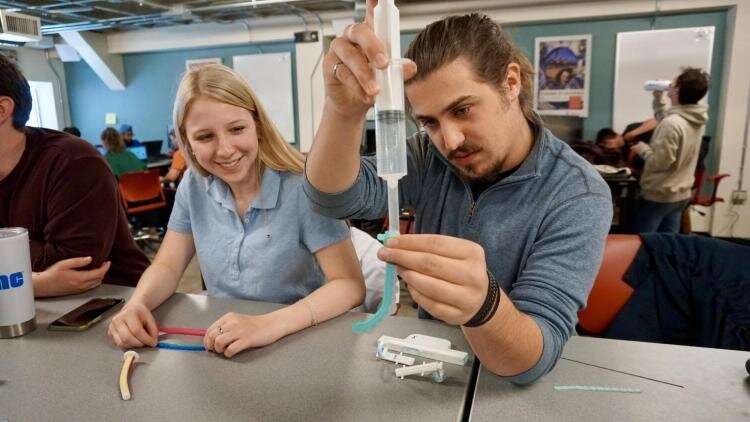Designing a soft robot to improve lung examinations

Seniors in the Department of Mechanical Engineering at the University of Colorado Boulder are designing a new soft robot to improve physicians’ ability to examine the deepest part of a patient’s lung.
Currently, there is only one system that can get down to the bottom of the lungs—a rigid catheter that could potentially cause inflammation. The team of mechanical engineering students are working with medical device company Medtronic on making the tip of that catheter more flexible.
“Our client is hoping to reduce the strain on the body by replacing the end of the device with something that is very compliant and soft, especially in comparison to the materials that are used today,” said Maxwell Anderson, the team’s logistics manager. “We’re trying to create a soft robot for the tip that will allow the physician to have more control of the end and have it be less abrasive toward the patient.”
The students are tackling this project as part of the department’s Senior Design course. They have spent the academic year researching, designing, molding and testing various iterations of their soft robot prototype.
An iterative design process
The team’s baseline design is a hollow, silicone tube with bubbles on the outside. The bubbles expand as the soft robot is inflated with air pressure, which causes the tube to bend. The students explained that the bending motion is the key aspect of their design, as that configuration is what allows the soft robot to move through the deeper parts of the lung.
“The catheter still does most of the work during the procedure, and then physicians control the soft robot at the very end to just move the tip,” said Renée Schnettler, the team’s project manager. “It can hook into different areas and allow doctors to send a needle through it to take a sample of any lung tissue they are studying.”
The team said they are constantly making new prototypes for testing purposes. The R&D process has resulted in 55 prototypes since fall 2021.
“A lot of what we’ve been doing is building off of our baseline design,” said Isaac Martinez, the CAD engineer on the team. “We watch how that prototype behaved and try changing certain dimensions. That would be one iteration. Then we change another aspect, like the number of bubbles, and that becomes a second iteration. We’ve been trying to put together this full picture from a lot of different prototypes.”
Each change in the prototype’s design has been targeted and intentional. That includes adjustments to the soft robot’s control system.
“Our control team has spent a lot of time just trying to figure out how we can tell where the tip of the robot is,” said electro-mechanical engineer William Wang. “We have been trying to improve our control systems to hit the desired positions, but each iteration of our prototype behaves slightly different depending on the material properties. We’ve been trying to find more robust techniques to control all of them.”
Prototyping for future ideas
The students emphasized that they are at the very beginning phase of this project. Their work is all preliminary research and development for Medtronic since the field of soft robotics is relatively new.
“Our project is a learning experience for us and Medtronic,” said Schnettler. “There’s not really a good way to model this. We can’t build a SolidWorks simulation and know how it’s going to behave. You just have to try it, and I think that’s why Medtronic wanted us to do it. We could just try a bunch of iterations over the year, and then they can scale it down and refine it in the future.”
Each of the students on the Senior Design team are proud that their project could one day have a bigger impact by helping patients and their families. Many of seniors have plans to continue this line of work and enter the biomedical engineering field after college.
Source: Read Full Article


